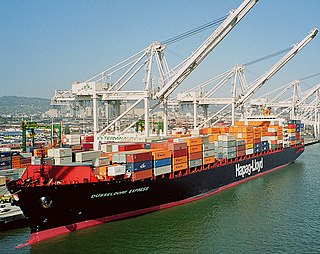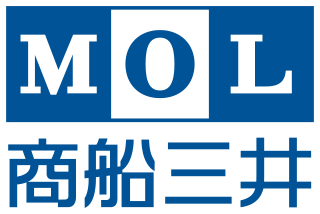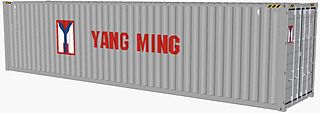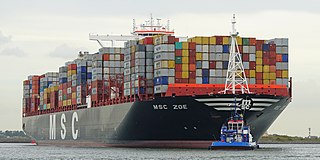
Christensen Canadian African Lines (CCAL) was a Norwegian cargo shipping company that traded between Canada and Africa between 1948 and 2000.

Christensen Canadian African Lines (CCAL) was a Norwegian cargo shipping company that traded between Canada and Africa between 1948 and 2000.
Consul Lars Christensen founded the company in 1948 after a suggestion by his friend Alfred Clegg of Kerr Steamship as a liner service provider between east coast of Canada and South Africa. The first sailing was undertaken by MV Norden in May 1948 with 1890 tons[ which? ] of cargo on board. CCAL aimed to compete with the British Elder Dempster Lines of Liverpool, which operated a liner service between South Africa and Atlantic North America via West Africa. The first year of operation showed a loss, which was however soon recovered in the following years.
The company, which was initially named Christensen Canadian South African Lines (CCSAL), was owned and operated by Lars Christensen's A/S Thor Dahl shipping company and appointed Kerr Steamship to providing the agency network in North America and Africa. CCSAL started up with three vessels setting up a monthly service: the chartered MV Norden and MV Valhall and the owned MV Thorscape (formerly the Philae). Soon Burntisland Shipbuilding Co supplied three new ships: MV Thorshall, MV Thorstrand and MV Thorsisle which were delivered between November 1948 and June 1949.
In 1951 Holland Africa line was appointed to operate the agencies in Africa. Kerr remained as agent for Canada only.
As traffic grew, it was decided to supplement the Burntisland vessels with larger and faster ships. Thor Dahl contracted three vessels of about 8000 tons deadweight in Bergen: MV Thorsgaard delivered in 1952, MV Thorscape delivered in 1954 and MV Thor I (1955) delivered in 1955. Thorsisle was transferred to Pacific Islands Transport Line after delivery of MV Thorsgaard. Other Thor Dahl vessels operated in the CCSAL were MV Thorsdrott that carried fruit, MV Thorsdrake, built in Germany to a typical German design, and MV Thorscarrier.
The main export cargo from Canada was newsprint, printing paper and other forest products. The bulk of this cargo from Canada was produced in areas far from Montreal and it was necessary for the vessels to call at other ports in the Gulf of Saint Lawrence and Saint Lawrence River to load paper. Calls were also made at such ports as Corner Brook, Newfoundland, Baie-Comeau, Port-Alfred and Trois-Rivières in Quebec. The St. Lawrence Seaway in those days could only accommodate vessels of up to about 3,000 DWT what meant that not all CCSAL vessels could make a call to this port as they had a greater deadweight tonnage. In Africa ports in South Africa, Mozambique and later Tanzania and Kenya were called. With further growth of the traffic, calls to Mombasa, Tanga and Dar es Salaam in East Africa were added and the company name changed into Christensen Canadian African Lines (CCAL). CCAL also started to call at some West African ports.
Thor Dahl then contracted a new trio at their own Framnaes shipyard in Sandefjord which were faster and close to 9,000 DWT: MV Thorshope delivered in 1958, MV Thorsriver delivered in 1959 and MV Thorstream delivered in 1960.
Early in 1960 negotiations were opened between the South African Citrus Exchange in Pretoria and CCAL to carry oranges from Cape Town to Montreal. Due to this contract, the company began to equip vessels with simple means of cooling that was not installed before. Later, when the vessels had sophisticated cooling chambers installed with the required ventilation, boxes as packaging were replaced with cartons.
CCAL had then even larger vessels built at Framnaes. MV Thorswave was operated from 1968 until she was sold in 1983, having by then made 62 round trips for the line.
Due to the decrease of cargo in the early to middle 1980's, it was decided that CCAL would no longer serve East Africa on a regular basis and that the vessels would turn around at Durban, or often Richard's Bay. When the Canadian government decided to join international sanctions against South Africa the import of agricultural products from South Africa to Canada was lost. In order to compensate for this, a call to ports in Portugal was added, causing an increased transit time between Cape Town and Montreal of about nine days. The cargo shipped consisted mainly of container traffic, with a small amount of general cargo. A further growth of the traffic between South Africa and Canada was caused by the departure of CCAL's competitor Fednav Group from the market due to the sanctions against South Africa. Later CCAL dropped the Portugal call as the cargo loaded was heavy weighting causing a too deep draft for the port of Montreal which resulted in discharging some cargo Quebec City already what made this traffic unprofitable.
CCAL also operated oil tankers, but due to the 1973 oil crisis it converted an order for two new tankers into one for ice-strengthened 20,000 DWT multipurpose cargo ships: MV Thorscape and MV Thor I (1978) which could also carry 2,000 tonnes of fruit per sailing in refrigerated holds. Additionally they could carry 400 TEU of containers. These two vessels were the last new ships for A/S Thor Dahl and left the trade in the late 1990s due to increased maintenance costs and because the engines were not as fuel-efficient as in more modern vessels.
On 31 August 2000 a deal was closed between A/S Thor Dahl and CP Ships allowing CP to buy Christensen Canadian African Lines (CCAL). CCAL operated at this time a 21-day multi-purpose service between Eastern Canada, Great Lakes and South Africa, using three "Astrakhan" type vessels.[ clarification needed ] CCAL had provided uninterrupted service for more than 50 years. CP Ships integrated CCAL into its Americana Ships division and merged it into the Lykes Lines brand. TUI AG bought CP and merged in 2006 in Hapag-Lloyd.
BIC Codes (Container prefixes): CACU
| Built | Name | Tonnage | Shipyard | Operated | Notes |
|---|---|---|---|---|---|
| Norden | chartered Danish vessel | ||||
| Valhall | timechartered for a southbound voyage in June 1948 | ||||
| 1948 | Thorscape | (ex Philae) - American-built vessel, abt. 6000 t.d.w | |||
| 1948 | Thorshall | 3,623 GRT | Burntisland Shipbuilding Company Ltd, Scotland | delivered November 1948 | |
| 1949 | Thorstrand | 3,712 GRT | Burntisland Shipbuilding Company Ltd, Scotland | 1949–1961 | delivered April 1949, 1961 sold to Poseidon Schiffahrt, Hamburg |
| 1949 | Thorsisle | 3,713 GRT | Burntisland Shipbuilding Company Ltd, Scotland | 1949–1966 | delivered June 1949, later transferred to Pacific Islands Transport Line, 1966 sold to Emil Offen & Co., Hamburg |
| 1952 | Thorsgaard | 5,077 GRT | A/S Bergens mek.Verksteder, Bergen | 1952–1958 | 1958 transferred to Norse Oriental Line (NOL). Replaced by the new Thorshope; scrapped 1983 |
| 1954 | Thorscape | 4,981 GRT | A/S Bergens mek.Verksteder, Bergen | 1954–1961 | 1961 transferred to Norse Oriental Line (NOL). |
| 1955 | Thor I | 4,993 GRT | A/S Bergens mek.Verksteder, Bergen | 1955–1960 | 1960 transferred to Pacific Island Transport Lines |
| Thorsdrott | name means "fruit" | ||||
| 1956 | Thorsdrake | 8,924 GRT | Flender-Werke AG, Lübeck, Germany | ||
| 1958 | Thorshope | 5,755 GRT | Framnæs Mek.Værksted, Sandefjord | ||
| 1959 | Thorscarrier | 8,590 GRT | Uddevallavarvet | ||
| 1959 | Thorsriver | 5,760 GRT | Framnæs Mek.Værksted, Sandefjord | ||
| 1960 | Thorestream | 5,758 GRT | Framnæs Mek.Værksted, Sandefjord | ||
| 1967 | Thorestream | 10,132 GRT | Framnæs Mek.Værksted, Sandefjord | ||
| 1977 | Thorscape | 14,794 GRT | Mitsui Engineering & Shipbuilding Co., Ltd., Tamano Works | 2000 MT cooled cargo, 400 TEU containers, multipurpose cargo ship | |
| 1978 | Thor I | 14,794 GRT | Mitsui Engineering & Shipbuilding Co., Ltd., Tamano Works | 2000 MT cooled cargo, 400 TEU containers, multipurpose cargo ship, last newbuilding |
This article includes a list of references, related reading, or external links, but its sources remain unclear because it lacks inline citations .(June 2009) |

A container ship is a cargo ship that carries all of its load in truck-size intermodal containers, in a technique called containerization. Container ships are a common means of commercial intermodal freight transport and now carry most seagoing non-bulk cargo.

Hapag-Lloyd AG is a German international shipping and container transportation company. It was formed in 1970 through a merger of Hamburg-American Line (HAPAG) and Norddeutscher Lloyd.

Mitsui O.S.K. Lines is a Japanese transport company headquartered in Toranomon, Minato, Tokyo, Japan. It is one of the largest shipping companies in the world.

Yang Ming Marine Transport Corporation is a Taiwanese container shipping company based in Keelung, Taiwan (ROC).

A cargo ship or freighter is a merchant ship that carries cargo, goods, and materials from one port to another. Thousands of cargo carriers ply the world's seas and oceans each year, handling the bulk of international trade. Cargo ships are usually specially designed for the task, often being equipped with cranes and other mechanisms to load and unload, and come in all sizes. Today, they are almost always built of welded steel, and with some exceptions generally have a life expectancy of 25 to 30 years before being scrapped.

Mediterranean Shipping Company S.A, branded as MSC is an international shipping line founded by Gianluigi Aponte in Italy in 1970. The company is owned by the Aponte family with its headquarters in Switzerland since 1978. It is the world's largest container shipping company by both fleet size and cargo capacity, controlling about 19.7 percent of the global container ship fleet.
Canadian Pacific Limited was created in 1971 to own properties formerly owned by Canadian Pacific Railway (CPR), a transportation and mining giant in Canada. In October 2001, CPR completed the corporate spin-offs of each of the remaining businesses it had not sold, including Canadian Pacific Railway Limited.

The modern terms short-sea shipping, marine highway and motorways of the sea, as well as the more historical terms coastal trade, coastal shipping, coasting trade and coastwise trade, all encompass the movement of cargo and passengers mainly by sea along a coast, without crossing an ocean.

CP Ships was a large Canadian shipping company established in the 19th century. From the late 1880s until after World War II, the company was Canada's largest operator of Atlantic and Pacific steamships. Many immigrants travelled on CP ships from Europe to Canada. In the early 20th century the sinking of the Canadian Pacific steamship RMS Empress of Ireland just before World War I became largest maritime disaster in Canadian history. The company provided Canadian Merchant Navy vessels in World Wars I and II. Twelve vessels were lost due to enemy action in World War II, including the RMS Empress of Britain, which was the largest ship ever sunk by a German U-boat.

Colombo Express was one of the largest container ships in the world. When launched in 2005, she was claimed by her owner to be the world's largest container ship, a title she held until Emma Mærsk was launched in 2006.
Ivarans Rederi AS was a merchant steamship company founded in Norway by Ivar Anton Christensen in 1902. The flag was red with a white "C" in the middle, for the founder's family name: Christensen.

Contship Containerlines was a global container carrier operating from 1969 to 2005 in the India/Pakistan, Levant, Australia/New Zealand, South America and Asia trade, mainly to and from Europe. The company was founded just as containerization was beginning and continuously grew up with the growth of this market.

Fednav is a privately owned Canadian company in the maritime transport industry, involved in transporting over 30 million tonnes of bulk cargo and break bulk cargo worldwide. Its fleet comprises approximately 120 long-term and spot chartered vessels. The fleet includes most of St. Lawrence Seaway's maximum-sized bulk carriers, Supramax, and Panamax vessels.
Portline Transportes Marítimos Internacionais, SA., often simply called Portline is a Portuguese shipping company. The company has diverse business activities, including dry bulk, containerised, and break-bulk cargo shipping, shipping agency, forwarding and logistics services, ship management and manning, ship brokerage and chartering, and a container depot service.
Lykes Bros. Steamship Co., also called Lykes Lines, was a cargo shipping company acting from the beginning of the 20th century to 2005 having its main business in the trade to and from the United States.

The Type C4-class ship were the largest cargo ships built by the United States Maritime Commission (MARCOM) during World War II. The design was originally developed for the American-Hawaiian Lines in 1941, but in late 1941 the plans were taken over by the MARCOM.

CSAV is a Chilean shipping company that is currently the largest company of its type in Latin America and also one of the oldest ones, having been founded in 1872.

The Burntisland Shipbuilding Company was a shipbuilder and repairer in Burntisland, Fife, Scotland that was founded in 1918. In 1969 it was taken over by Robb-Caledon Shipbuilders, which in turn was nationalised in 1977 as part of British Shipbuilders.

Kyoto Express is a container ship of the Colombo Express class of ships owned and operated by Hapag-Lloyd AG. Registered in Monrovia, Liberia, the vessel has been in operation since 2005.
Dart Containerline Co Ltd was a consortium of shipping companies that commenced operations in 1969, thus becoming one of the first container shipping operators.